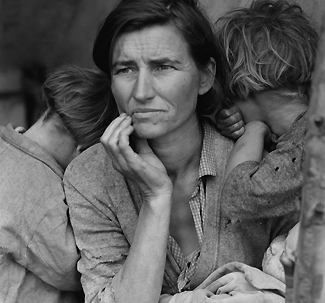| |
The Great Depression: a phrase synonymous with a financial and emotional upheaval that still haunts our country. Most of us have friends or relatives that tell stories of living through a time that we can only imagine. Echoes of those memories find their way into our thoughts even today – the “what if’s” of fear that live deep in the psyche of Americans, young and old alike.
President Roosevelt’s New Deal was the foundation from which sprang multiple programs that focused on, what historians call the “3 Rs”: Relief, Recovery, and Reform. The Farm Security Administration came into being during the mid 1930’s and lasted to the mid 1940’s. The FSA was committed to improve the lifestyle of the rural farmer, and among its various programs was a project that dealt with photographing the plight of poor farmers, and migrant workers. This assignment was one of the first in the documentary photography genre. The photos this government sponsored program captured, covered a period of our history in a way that had never been done before. Their motto was simply, as Beaumont Newhall – renowned photographer and art historian - insisted, “not to inform us, but to move us”. And these photos indeed, sealed scenes of pathos in our hearts, photos that most Americans today would recognize as coming from that era.
Close to 175,000 photographs are in this formidable collection - photo’s that emerged from an assignment to capture the reality of America’s poor. Reality targeted to show the masses that Roosevelt’s programs were working, that things were getting better, black and white moral boosters delivered to the doorsteps and hearts of people in desperate need of encouragement. In charge of this massive assignment, connecting photographers with one another and Washington was Rexford Tugwell, economic advisor at the time to President Roosevelt. Tugwell sent photographers to the nation’s heartland to document “Americans for America”. What resulted was the largest collection of black and white photographs our nation has ever seen.
What came out of this endeavor were raw, ragged portraits of exhausted emigrants. Shots that showed individuals and families living in their cars, pitching tents beside the road, small tent cities scattered throughout the western region. Trucks with boxes and gunny sacks piled high; moving homesteads that held small pieces of former lives and fragile dreams. These people with tough sinuous determined souls headed toward the Mecca of a new land, a new world where work and food was plentiful. Or so they were told.
Most of the few thousand that were actually relocated ended up in camps called “Green Belts”. John Steinbeck wrote extensively during this time period, his most well-known, and poignant book, The Grapes of Wrath is set in Weed Patch – a relocation camp just outside of Bakersfield, California. Rural farmers and migrant workers headed west with dogged steps, sun baked skin, malnourished babies and hearts filled with hope. Hope that held itself clenched within a tight fist of despair.
The photographers roamed the high-ways and bi-ways from the dust bowl to the west coast attempting to capture the essence of the times. They showed us the texture of poverty, the mantle of hope, the crushing reality of despair. We also see evidence that regardless of the circumstance, people find a way to push through difficult times, looking forward to a happier, more prosperous future.

Dorothea Lange 1935 | Resettled farm child from
Taos Junction to Bosque Farms project. NM
| |

|

